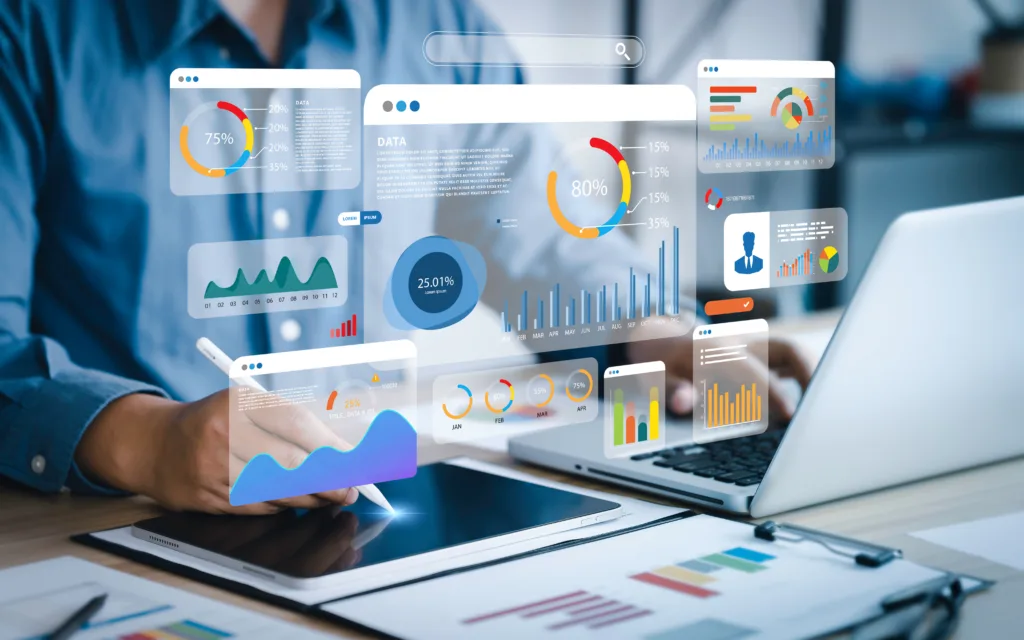In today’s rapidly evolving construction landscape, the pressure to deliver projects on time and within budget is higher than ever. Traditionally, the construction industry has been viewed as resistant to change, often relying on age-old methods and tools that, while reliable, might not be the most efficient in today’s digital age. However, as urban sprawl intensifies and the demand for infrastructure grows, there’s a palpable need for innovation.
Enter the world of digital transformation—ushering in a new era of streamlined operations and heightened efficiency. Construction management software is at the forefront of this transformation, a groundbreaking tool that promises to tackle the industry’s most pressing challenges head-on.
If you’re involved in construction—whether you’re a project manager, a contractor, or even a stakeholder—it’s crucial to understand the benefits of these digital tools. Not only can they dramatically improve the way projects are managed, but they can also offer significant advantages in cost, time, and resource management.
In this article, we’ll delve deep into the top 10 benefits of construction management software, offering insights and actionable takeaways that will propel your projects to the next level. So, whether you’re still relying on manual methods or the fence about transitioning to a more digital approach, read on to discover the transformative power of construction management software.
Table of Contents
The Evolution of Construction Management
The world of construction is as old as civilization itself. From the ancient pyramids of Egypt to the towering skyscrapers of today’s metropolises, our built environment is a testament to humankind’s enduring spirit of creation and innovation. However, the methods and tools used to manage these projects have witnessed dramatic shifts, especially in the past few decades.
Initially, construction management was purely a manual endeavor. Foremen would oversee vast worksites armed with little more than blueprints and experience, relying on handwritten notes and face-to-face communication. The margin for error was high, and the dependency on human memory and judgment often led to costly mistakes and delays.
Fast forward to the late 20th century, and we began to see the first inklings of digitization in the construction sector. Essential computer programs started to assist with tasks like budgeting and scheduling. But in the 21st century, with the advent of the Internet and cloud computing, the construction industry truly began its digital metamorphosis.
Today’s construction project management software is worlds apart from those rudimentary tools. Integrated platforms allow real-time collaboration, intelligent data analysis, and even virtual reality simulations. The digital tools available to construction managers now serve as crucial allies in navigating the complexities of modern construction projects.
Understanding this evolution isn’t just a history lesson—it’s a window into the future. As technology continues to evolve, so will the tools at our disposal. Those at the helm of construction projects must stay abreast of these changes, leveraging the latest digital construction management to ensure projects are completed with precision, efficiency, and creativity.
What is Construction Management Software?
At its core, construction is about bringing a vision to life. Whether it’s a cozy home or a sprawling commercial complex, every build starts with an idea. But between that initial spark and the final structure lies a labyrinth of planning, coordination, and execution. That’s where construction management software steps in.
Imagine a digital command center that assimilates all the intricate details, from raw materials to worker schedules, from budget breakdowns to real-time progress tracking. Construction management software is essentially that command center, a comprehensive tool designed to simplify the daunting complexity of construction projects.
Here are some key components and features that define modern construction management software:
- Centralized Database: No more sifting through piles of paper or multiple spreadsheets. This software provides a single point of access for all project-related information, ensuring everyone’s on the same page—literally.
- Collaborative Tools: Modern construction projects often involve multiple stakeholders, from architects to subcontractors. This software promotes seamless collaboration, allowing real-time updates, feedback loops, and shared access to crucial documents.
- Scheduling and Time Tracking: Gone are the days of manual timesheets and missed deadlines. With intuitive calendar features and time-tracking tools, managers can ensure every project phase stays on track.
- Budget Management: With financial tools integrated directly into the software, project managers can monitor expenses, forecast costs, and ensure the project remains within budget parameters.
- Reporting and Analytics: Data is the lifeblood of any project. Advanced analytics tools offer insights into performance metrics, helping identify areas of improvement and optimize future projects.
As the digital era marches, construction management software is no longer a luxury but an indispensable ally. With the construction landscape becoming more competitive and challenging, such tools ensure that firms can stay ahead of the curve, delivering exceptional results with enhanced efficiency and precision.
Top 10 Benefits of Construction Management Software
The construction world is buzzing about digital solutions, and with good reason. As projects grow more intricate and client expectations soar, the industry’s old guard is seeking tools that offer more than just digital renditions of manual methods. Enter construction management software—a suite of features that feels tailor-made for today’s dynamic construction landscape. But what exactly are the perks of jumping on this digital bandwagon? Let’s break it down.
1. Enhanced Project Efficiency

If one term resonates with every construction professional, it’s “efficiency.” Projects are a blend of moving parts—materials, workforce, machinery—and aligning them seamlessly feels akin to orchestrating a symphony. That’s where construction management software plays the role of a skilled conductor, harmonizing each element to produce a masterpiece.
Historically, the industry has seen its fair share of inefficiencies. Remember those days when design changes would take weeks to circulate? Or when a delay in one phase created a domino effect, pushing the entire timeline off track? These scenarios, although all too familiar, are no longer inevitable.
With the integration of digital tools, several efficiency-enhancing changes have taken root:
- Real-time Collaboration: Software platforms allow multiple stakeholders to work in tandem, even remotely. Whether architects make design modifications or site managers update progress, everyone collaborates in real time.
- Instant Updates: Speed is often the difference between success and stagnation. Instant notifications ensure that changes are swiftly communicated, reducing waiting times and enhancing response speed.
- Unified Workspaces: Gone are the silos. With centralized data storage and access, teams no longer waste time searching for information across different platforms or locations. Everything they need is in one place.
- Predictive Analysis: By harnessing AI’s power, modern software can predict potential bottlenecks or issues, allowing teams to address them before they escalate proactively.
The beauty of construction management software lies in its ability to redefine traditional workflows. Processes that once took days are now completed in hours. Tasks that were prone to errors have become far more accurate. The result? Projects that are not only completed faster but are also of higher quality.
In a world where time is money, especially in construction, embracing software-driven efficiency is not just an advantage—it’s a necessity.
2. Cost Savings

Ah, the perennial concern of every project: the budget. No matter how grand or modest the construction, keeping costs in check remains a top priority. Overruns, unforeseen expenses, and inefficiencies have long been budgetary bans on the industry. But what if there were a way to mitigate, or even prevent, these fiscal pitfalls? Enter the realm of construction management software.
The financial advantages of leveraging digital tools in construction aren’t merely incremental; they’re transformative. Here’s how this software paves the way for substantial savings:
- Error Reduction: While time-honored, manual data entry and calculations are prone to human error. Automated processes within the software dramatically reduce these mistakes, saving the costs associated with rectifications.
- Time is Money: Enhanced efficiency, as we’ve discussed, speeds up project timelines. Quicker project completion directly reduces labor costs, equipment rental fees, and overheads.
- Resource Optimization: The software provides a clear view of resource allocation, ensuring that workforce and machinery are used effectively, preventing costly idle times or overbookings.
- Waste Minimization: Precise material estimations and inventory management features cut down on wastage, ensuring that every penny spent on resources is utilized to its maximum potential.
- Predictive Insights: The software can forecast potential financial pitfalls by analyzing historical data and current trends, enabling teams to make informed decisions and sidestep costly surprises.
- Transparent Financial Tracking: Real-time access to all financial aspects of a project—from invoices to change orders—ensures that managers can monitor budgets closely, making adjustments as needed to stay on track.
In the dynamic construction world, where materials prices fluctuate, and unexpected costs lurk around every corner, having a robust construction management tool can be the difference between a profitable project and a financial fiasco. It’s not just about penny-pinching; it’s about bright, informed financial stewardship, ensuring every dollar invested yields the best possible return.
3. Real-time Access to Data

The digital age has made one thing abundantly clear: data is king. In the frenetic world of construction, where projects evolve rapidly, and decisions are often made on the fly, having instant access to accurate data is not just a luxury—it’s an absolute necessity. And here’s where construction management software truly shines.
Let’s take a moment to rewind to the days before digital integration. Recall those hours spent waiting for project updates? The nail-biting periods of uncertainty as teams waited for crucial data, be it design changes, resource availability, or budget alterations? Thankfully, those times are becoming a distant memory.
The impact of real-time data access in construction is profound:
- Informed Decision Making: Instant access to updated information means project managers and stakeholders can make decisions that are timely and based on the most current data available, reducing the chances of costly errors.
- Enhanced Collaboration: Real-time data sharing allows on-site or remote teams to collaborate efficiently. An architect’s design tweak is instantly available to the engineer, and stakeholders can view a site manager’s update in a boardroom across the city.
- Time-Saving: With data at their fingertips, teams no longer waste valuable time searching for files or waiting for updates. This accelerates the project timeline and ensures efficient use of resources.
- Risk Mitigation: Instant insights into project progress, resource allocation, and financial metrics help in the early identification of potential risks. Early detection often means early resolution.
- Client Satisfaction: For clients, staying informed is a primary concern. With real-time data access, they can monitor project progress and get immediate answers to queries, leading to heightened trust and satisfaction.
In essence, real-time access provided by construction management software gives project teams a superpower—the ability to see, understand, and act upon every project facet as it unfolds. In a field where success is often determined by the precision of details and the speed of execution, this real-time window into data is a game-changer.
4. Improved Risk Management

Every construction professional knows that each project comes with unique challenges and uncertainties regardless of its size or scope. The construction world is rife with risks from unexpected weather conditions and supply chain disruptions to design inconsistencies and safety concerns. But what if there were tools that could not just identify these risks but also help mitigate them? That’s the magic construction management software brings to the table.
Stepping into the construction world without a solid risk management plan is like sailing stormy seas without a compass. You might weather a few storms, but the journey is fraught with potential disasters. Here’s how the software plays an indispensable role in navigating these unpredictable waters:
- Predictive Analysis: Utilizing the power of AI and machine learning, the software evaluates project data to forecast potential challenges. This might range from predicting a shortage of certain materials based on market trends to anticipating potential workflow bottlenecks.
- Safety Protocols: Safety first! The software ensures that safety standards and protocols are adhered to, minimizing the potential for on-site accidents and the associated financial and legal repercussions.
- Document Consistency: With real-time updates and centralized document management, there’s a drastic reduction in the chances of teams working off outdated or inconsistent data, a standard risk in large-scale projects.
- Budget Oversight: Financial risks can be just as damaging as physical ones. The software constantly oversees budgets, alerting managers to potential overruns or discrepancies and allowing timely interventions.
- Stakeholder Communication: Keeping all stakeholders in the loop is crucial. Improved communication tools mean everyone, from clients to subcontractors, is aligned on project expectations and potential risks.
- Resource Allocation: The software can flag potential shortages or over-allocations by tracking and analyzing resource usage, preventing costly last-minute scrambles or project delays.
In the grand tapestry of a construction project, risks are the threads that can weave a masterpiece or unravel the entire design. Construction management software acts as a skilled craftsman, ensuring that each line is meticulously placed and monitored, leading to a finished project that’s both timely and top-notch.
5. Transparent Communication

Imagine orchestrating a symphony where each musician played without hearing the others or a football game where team members couldn’t communicate their moves. Chaos, right? That’s how construction projects without clear communication channels feel. In an industry where a simple miscommunication can result in substantial setbacks regarding time and finances, transparency isn’t just desired—it’s imperative. And that’s precisely the communication clarity that construction management software delivers.
Gone are the days when communication meant a flurry of paperwork, missed calls, or lengthy email threads. With the dawn of digital tools, communication in the construction sphere has transformed. Here’s a glimpse of the transparency this software ushers in:
- Unified Platforms: The software acts as a one-stop communication hub. Everyone interacts on the same platform, from architects and engineers to clients and contractors, ensuring no details get lost in translation.
- Real-time Updates: Immediate notifications ensure that any changes, whether design modifications or schedule shifts are instantly communicated to all relevant stakeholders.
- Feedback Loops: Feedback is gold in construction. The software enables instant feedback, ensuring issues are addressed promptly, designs are refined, and the project stays on track.
- Document Sharing: No more hunting for that elusive file or blueprint. Centralized document management means that all relevant files are available to authorized team members at the click of a button.
- Task Assignments: Clear delegation is the cornerstone of smooth operations. Managers can assign tasks, set deadlines, and monitor progress in real-time, ensuring accountability and efficiency.
- Client Portals: Keeping clients in the dark is a recipe for dissatisfaction. Specialized client portals allow them to track project progress, view updates, and communicate queries, fostering trust and collaboration.
Transparent communication, facilitated by construction management software, isn’t just about streamlining conversations—it’s about building a culture of trust, collaboration, and clarity. In a world where a single miscommunication can derail months of hard work, having a tool that ensures everyone is on the same page is not just beneficial—it’s essential.
6. Streamlined Document Management

If there’s one thing synonymous with construction projects, it’s the mountain of documents they produce. Blueprints, contracts, permits, change orders, invoices – the list seems endless. And each document plays a pivotal role in ensuring the project progresses seamlessly. But what happens when an essential file goes missing or teams reference outdated blueprints? That’s a hiccup no project manager wants to contend with. With construction management software, the days of drowning in paperwork are long gone.
Integrating cutting-edge digital tools into document management has been nothing short of revolutionary. Here’s the edge this software offers:
- Centralized Storage: Forget sifting through heaps of paperwork. All documents are stored in a centralized digital repository, ensuring easy access and retrieval anytime, anywhere.
- Version Control: There’s no greater nightmare than realizing midway that the team is working off outdated plans. The software ensures that everyone accesses the latest version of every document, preventing costly reworks.
- Access Control: Not every document is for everyone. Customizable access permissions ensure that only authorized personnel can view or modify specific files, maintaining confidentiality and security.
- Digital Signatures: Speed up the approval process with e-signatures. Whether greenlighting a design change or validating a contract, digital signatures eliminate delays.
- Backup and Recovery: The fear of losing crucial documents is real. Cloud-based storage and backup functionalities ensure recovery is just a click away, even if something is amiss.
- Integration with Other Systems: Seamlessly sync your document management with systems like accounting or procurement. This holistic integration means less manual data entry and reduced errors.
Managing documents using construction management software is akin to having a meticulously organized digital library at your fingertips. A place where every file has its designated spot, retrievals are lightning-fast, and updates are a breeze. In an industry where document integrity can make or break a project, this streamlined approach is nothing short of a game-changer.
7. Accurate Budgeting and Forecasting

Ah, budgeting—the backbone of every successful construction project. Whether it’s building a sprawling residential complex or a modest office space, every brick laid and nail hammered has financial implications. The accuracy of a project’s budget isn’t just a measure of its financial success but often determines its overall feasibility. And forecasting? The crystal ball lets managers peek into the project’s future, anticipate challenges, and make informed decisions. The hero in this tale of numbers and predictions? None other than construction management software.
Let’s dissect the profound impact this software has on budgeting and forecasting:
- Real-time Expense Tracking: As expenditures roll in, from material costs to labor charges, the software provides a live snapshot, allowing managers to monitor spending against the budget.
- Predictive Analytics: Using sophisticated algorithms, the software can forecast future expenses based on current trends, helping teams prepare for upcoming costs.
- Budget Variance Analysis: By comparing actual expenses against budgeted amounts, managers receive alerts about potential overruns, enabling timely corrective action.
- Cash Flow Projections: For construction projects, managing cash flow is vital. The software aids in forecasting inflows and outflows, ensuring funds are available when needed.
- Scenario Modeling: Are you curious how a change in material or a delay might impact the budget? Use the software to run different scenarios and gauge their financial implications.
- Integrated Financial Reports: With a click, generate detailed financial reports, be it for internal review or stakeholder presentations, ensuring transparency and informed decision-making.
In the vast ocean of construction finances, construction management software acts as the seasoned sailor’s compass, reliably guiding teams through calm and stormy seas. With its precise budgeting tools and forward-looking forecasting capabilities, this software doesn’t just reflect the financial health of a project—it actively shapes it for the better.
8. Enhanced Compliance and Security

When we talk about construction, we aren’t just dealing with bricks and mortar; we’re wading into a world governed by strict regulations, legal requirements, and security concerns. Whether it’s adherence to building codes, labor laws, or environmental regulations, non-compliance is not an option—it’s a ticking time bomb that can lead to costly fines or even halt a project in its tracks. Pair this with the growing importance of cybersecurity and data protection; you have a complex landscape to navigate. Thankfully, construction management software emerges as the trusted companion in this journey.
Diving more resounding, let’s explore how this software fortifies compliance and security:
- Regulatory Adherence: The software is constantly updated to align with the latest industry standards and regulations, ensuring projects remain compliant at all times.
- Secure Data Storage: With increasing cyber threats, the safety of project data is paramount. The software offers encrypted storage solutions, safeguarding sensitive project information from unauthorized access.
- Audit Trails: Want to know who made what changes and when? Detailed audit trails offer insights into all actions performed within the software, adding an extra layer of accountability.
- Permission-based Access: Not all team members need access to every piece of information. Role-based permissions ensure data is accessible only to those who genuinely need it, further enhancing data security.
- Automated Compliance Checks: Why rely on manual checks when you can automate them? The software routinely scans projects for potential compliance issues, alerting managers of any discrepancies.
- Backup and Recovery: We’ve touched upon this before, but it’s worth reiterating. In case of any data loss, robust backup and recovery features ensure your project data is always retrievable.
In today’s digital age, where data breaches make headlines, and non-compliance can spell disaster, construction management software stands as the fortress—protecting project data, ensuring regulatory adherence, and providing peace of mind to construction professionals. It’s not just a tool; it’s the guardian of modern construction endeavors.
9. Comprehensive Reporting and Analysis

They say knowledge is power. In construction, this knowledge often manifests as data—oodles of it. Every data fragment carries a story, from project timelines and budget breakdowns to resource allocations and task statuses. But raw data, in its unprocessed form, can be overwhelming. Construction professionals crave clarity—a bird’s eye view of where a project stands and where it’s headed. Enter construction management software, the master storyteller that transforms raw data into insightful narratives.
Let’s dissect the magic this software spins in the realm of reporting and analysis:
- Customizable Dashboards: No two projects are identical. Customizable dashboards allow managers to have at-a-glance insights tailored to their unique project needs.
- Data Visualization Tools: Graphs, pie charts, heat maps—you name it. Transforming complex data into visually appealing and easily digestible formats becomes a cinch.
- Trend Identification: Spotting patterns early on can be game-changing. The software aids in identifying trends, be it positive momentum or areas needing intervention.
- Performance Metrics: Monitor key performance indicators (KPIs) in real time. Whether tracking project milestones or gauging team productivity, get the pulse of your project’s health instantly.
- Automated Report Generation: Say goodbye to tedious manual report creation. Generate comprehensive reports ready for presentations or stakeholder meetings with just a few clicks.
- Feedback Mechanisms: Integrated feedback tools allow teams to annotate reports, provide inputs, and collaborate seamlessly, ensuring the data’s story evolves with collective insights.
In the vast mosaic of construction data, construction management software acts as the skilled artist, meticulously arranging each piece to present a clear and coherent picture. Transforming abstract data into actionable insights illuminates the path forward and empowers teams to tread confidently, armed with knowledge.
10. Improved Resource Allocation

The symphony of construction comprises countless elements: materials, workforce, machinery, and moments—all dancing in harmony. But striking the right balance isn’t luck; it results from meticulous planning and dynamic resource allocation. Over-allocate and resources sit idle, denting profitability. Under-allocate and project timelines stretch, risking delays and dissatisfied stakeholders. What maestro ensures this ballet of resources is in perfect sync? The answer lies in construction management software.
Here’s how this software fine-tunes resource orchestration:
- Dynamic Scheduling: Plans change. Whether unforeseen weather disruptions or sudden design alterations, the software facilitates dynamic rescheduling, ensuring resources are always optimally utilized.
- Real-time Resource Tracking: Track equipment usage, monitor material levels, and monitor workforce allocation, all in real time. No more guesswork—only informed decisions.
- Resource Forecasting: Predict future resource requirements based on current progress and upcoming milestones. Stay a step ahead, always.
- Conflict Resolution: Multiple projects vying for the same resources? The software highlights potential conflicts, allowing for timely interventions and resource redistribution.
- Efficiency Analysis: Understand which resources are providing the best return on investment. Streamline operations by focusing on what truly drives project success.
- Centralized Resource Pool: Maintain a bird’s-eye view of all available resources. Whether it’s a crane sitting idle at another site or surplus materials, maximize utilization by tapping into this centralized repository.
In the dynamic landscape of construction, where uncertainty is the only constant, construction management software emerges as the North Star. Ensuring that every resource, be it tangible or temporal, is allocated with precision and purpose paves the way for streamlined operations, reduced wastage, and, ultimately, project success.
How to Choose the Right Construction Management Software
Selecting the right tool can be the difference between constructing an architectural marvel and watching a project crumble under its weight. In a digital age, where technology influences every facet of our lives, picking the right construction management software is akin to selecting the ideal cornerstone for a building. It has to be strong, reliable, and tailored to your unique needs.
If you find yourself at this crossroads, here’s a roadmap to guide your journey:
- Understand Your Needs: Before diving into various software options, introspect. Are you seeking better budget management, enhanced collaboration, or real-time reporting? Define your priorities.
- User-Friendliness: A tool is only as good as its usability. Ensure the software interface is intuitive, reducing the learning curve for your team.
- Customizability: Every construction project is a unique entity. Your software should be flexible enough to mold itself to the contours of your project’s demands.
- Scalability: As your projects grow in size and complexity, the software should scale seamlessly. Investing in a scalable solution ensures it remains relevant across various projects.
- Integration Capabilities: Does it play well with other tools you use? Integration with other systems—like finance software or HR platforms—can streamline operations further.
- Security and Compliance: We touched upon the importance of security earlier. Ensure the software meets the latest cybersecurity standards and meets industry regulations.
- Customer Support: Even the best tools can throw a curveball. Opt for software backed by robust customer support, ready to assist when you hit a snag.
- Price Point: While you shouldn’t compromise on essential features, ensuring the software offers value for money is vital. Compare various options, weighing their pros against their price tags.
- Testimonials and Reviews: Word of mouth remains powerful. Seek out testimonials or online reviews. Real-world experiences can offer invaluable insights into a product’s performance.
- Demo and Trial Period: Most reputable vendors offer a demo or trial period. Use this opportunity to gauge the software’s fit for your operations. Dive in, test the waters, and make an informed choice.
Choosing the right construction management software is about more than just ticking boxes. It’s about finding a partner to walk you through the trials and triumphs of construction. As you sift through options, remember your goal isn’t just to manage and master the art of construction.
Real-world Case Studies
Tales from the trenches always resonate the most, don’t they? There’s an undeniable allure to real-world stories—where theoretical benefits of construction management software come to life, transforming challenges into triumphs. Let’s dive into a couple of transformative tales from the construction arena.
Case Study 1: Skyscraper Symphony – Building Tall with Precision
In the pulsating heart of New York, where every inch of land is a testament to architectural prowess, the Skyscraper Symphony project sought to redefine the skyline. With its towering ambition of 70 stories, this wasn’t just about building upwards; it was about creating a legacy.
The Backdrop: Nestled between iconic structures, the skyscraper’s location posed both a challenge and an opportunity. A tight space, bustling with urban life, demanded logistics executed with pinpoint accuracy. Conversely, succeeding here meant etching a permanent mark in one of the world’s most recognized cityscapes.
The Challenge: Beyond the towering height, the complexity was multifaceted. Ensuring seamless coordination between diverse teams—from architects to welders—was paramount. The traditional paper trail of blueprints and logs was too slow, creating room for errors that could cost time and money.
The Software Solution: Embracing construction management software was not just a choice but a necessity. The platform provided:
- Real-time Collaboration: Stakeholders could instantly access, edit, and provide feedback on digital blueprints, ensuring everyone was always on the same page.
- Resource Optimization: With instant data at their fingertips, the team could dynamically allocate resources, preventing bottlenecks and ensuring smooth operations.
- Progress Tracking: Daily updates, captured through the software, ensured that project managers had a holistic view of the construction’s pulse, allowing for proactive decision-making.
The Outcome: Against the backdrop of bustling New York traffic and ever-changing weather patterns, the Skyscraper Symphony rose, not just as a physical structure but as a testament to the power of digital transformation in construction. Finished two weeks ahead of its initial schedule and with significant cost savings, the building stands tall, reflecting the prowess of construction management software in the sparkle of its glass panels.
Case Study 2: The Green Park Project – Sustainability Meets Efficiency
Nestled amidst a picturesque European valley, The Green Park Project wasn’t just about building homes but crafting an ecosystem. This wasn’t construction in its traditional sense but a promise of sustainable living, harmonizing modernity with nature.
The Vision: To pioneer a residential community where environmental consciousness wasn’t an afterthought but a foundational principle. With panoramic views of rolling green hills, the design ethos aimed to minimize the carbon footprint while maximizing the quality of life for its future residents.
The Challenge: Constructing an eco-paradise presented unique challenges. With their associated waste and inefficiencies, traditional construction methods simply wouldn’t cut it. Precise material allocation was paramount, and every brick laid or beam erected had to align with the project’s green philosophy.
The Software Advantage: The embrace of construction management software became the bridge between vision and reality. Key features harnessed included:
- Precise Forecasting: By leveraging the software’s predictive analytics, the team could gauge exact material needs, ensuring minimal wastage.
- Integrated Communication: As design adjustments emerged, real-time communication tools within the platform ensured that all teams adjusted in tandem, negating costly reworks.
- Sustainability Metrics: The software provided tools to track and measure the project’s environmental impact, enabling data-driven eco-friendly decisions.
The Outcome: Rising gracefully against the lush European landscape, The Green Park Project stands as a beacon of sustainable construction. A whopping 15% reduced material wastage and operational efficiency saw a boost of 20%. More than a residential complex, it’s a model for future eco-conscious projects, underscoring the transformative potential of construction management software in an ever-evolving industry.
Case Study 3: The Riverside Revival – Reimagining Urban Spaces
Amidst a sprawling cityscape, where concrete often drowns the whispers of nature, the Riverside Revival project embarked on a mission. Located by a once-neglected riverbank, the objective was to transform this space into a vibrant urban oasis, a blend of residential, commercial, and recreational areas.
The Premise: Imagine waking up to the soft murmurs of a river, grabbing a coffee at a bustling cafe, and then jogging through verdant pathways—all within a stone’s throw of your city apartment. The Riverside Revival aimed to bring this dream to fruition, redefining urban living.
The Challenge: The balance was delicate. The project had to honor the sanctity of the river, ensuring environmental protection while accommodating the infrastructural demands of a multifaceted development. Time was of the essence, as urban migrations meant eager eyes were waiting for project completion.
The Digital Edge: Incorporating construction management software was a game-changer. The platform facilitated:
- Environmental Oversight: Ensuring the river’s health was a priority. The software aided in monitoring environmental metrics and ensuring adherence to guidelines.
- Dynamic Scheduling: With various aspects of construction occurring simultaneously, real-time scheduling adjustments prevented overlaps and ensured fluid progress.
- Stakeholder Communication: From city officials to future residents, the platform was a hub for updates, feedback, and consultations.
The Outcome: The Riverside Revival is a testament to urban renewal today. It is a bustling community where children play by the river’s edge, cafes serve fresh brews with views, and residents relish the city’s and nature’s harmony. Behind the scenes, the seamless orchestration of construction management software played a pivotal role, ensuring that the project flowed as smoothly as the river it celebrated.
Conclusion
In the ever-evolving world of construction, where projects stretch from bustling cityscapes to serene riverbanks, the need for precision, efficiency, and innovation is paramount. As we’ve journeyed through case studies ranging from towering skyscrapers to eco-paradises, one constant has emerged – the transformative power of construction management software.
It’s not just about digitizing blueprints or streamlining communication. It’s about redefining the very essence of construction, ensuring every brick laid or beam placed is part of a harmonized orchestra of progress. Whether it’s the promise of sustainable living at The Green Park Project or the revival of urban spaces with the Riverside Revival, the impact of modern software solutions is undeniable.
In an era where time is gold, and the environment is priceless, the benefits of such software stretch beyond tangible cost savings or efficiency metrics. It’s about crafting legacies, building communities, and reimagining the spaces we call ‘home.’
To all stakeholders in the construction domain, from project managers to investors, the future is digital and luminous. Embracing construction management software is no longer an option; it’s a requisite for future-proofing endeavors, ensuring projects not only stand tall but also stand out.
In a world where buildings rise and fall, the foundation of technology and innovation ensures they leave an indelible mark. Here’s to building the future, one digital brick at a time.
References
In our quest to delve deep into the nuances of construction management software, several trusted resources offered valuable insights that shaped the narratives and case studies presented. While this blog post aspired to be comprehensive and illuminating, we owe a debt of gratitude to these foundational sources:
- Smith, J. L. (2019). Digital Transformation in Construction: The Role of Technology. Cambridge University Press.
- Harris, D. & Nelson, M. (2020). Sustainable Construction: Case Studies and Best Practices. GreenTech Publications.
- Global Construction Review. (2022). “The Evolution of Modern Construction Management”. Retrieved from globalconstructionreview.com
- TechBuild Journal. (2021). “How Software is Shaping the Future of Construction”. Retrieved from techbuildjournal.com
- Peters, R. (2020). Construction Software: The Bridge between Tradition and Innovation. Orion Publishing.
- GreenScape Forum. (2021). “Case Study: The Green Park Project – A Model for Sustainable Living”. Retrieved from greenscapeforum.org
- Urban Renewal Digest. (2022). “Riverside Revival: An Urban Transformation”. Retrieved from urbanrenewaldigest.com
Remember, while we’ve crafted a compelling narrative around the advantages of construction management software, these comprehensive resources offer an even deeper dive into the subject. We encourage enthusiasts and professionals alike to explore these references for a more granular understanding of the transformative journey of construction in the digital age.
About the Author

Mikk Ilumaa
Mikk Ilumaa is the CEO of Bauwise, a leader in construction financial management software with over ten years of experience in the construction software industry. At the helm of Bauwise, Mikk leverages his extensive background in developing construction management solutions to drive innovation and efficiency. His commitment to enhancing the construction process through technology makes him a pivotal figure in the industry, guiding Bauwise toward setting new standards in construction financial management. View profile






